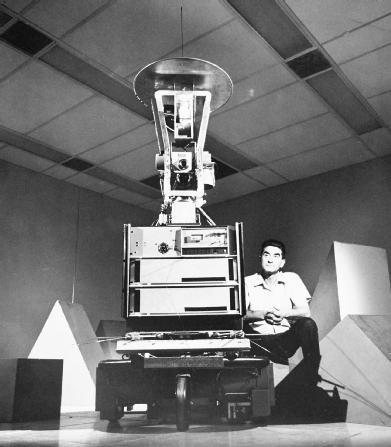 Charles Rosen’s Shakey was an early AI that could move withot bumping into things |
Science Fiction is rife with intelligent machines. C-3PO in “Star Wars,” the HAL 9000 in “2001: A Space Odyssey,” KITT from “Knight Rider,” Data from “Star Trek: The Next Generation,” the Terminator, Sonny from “I, Robot,” the agents from “The Matrix,” and the deceptively artificial humans from the movies “A.I.” and “Westworld” are commonplace in our fictional futures.
Video games are filled with AIs who compete against human players. The better the AI, the more challenging gaming experience. Since computers started decisively beating the best chess players on Earth, grandmasters have started coaching competing chess AIs against each other. Artificial Intelligence is already integrated into our interactive entertainment, and holds promise for more real-world applications as well.
But is AI really “intelligent?” The father of modern computer science Alan Turing, described a test for determining a machine’s capability of demonstrating thought: a human judge enters a chat room with a human and a computer program, if they cannot identify which is the human and which is the machine, then the machine qualifies as intelligent. This procedure is known as the Turing Test.
A.L.I.C.E is a ChatBot that holds promise for one day passing the Turning Test. ALICE scans sentences given to it in online chat for keywords and returns one of hundreds of appropriate responses based on the context of the conversation. You can chat with ALICE online at alicebot.org.
ALICE does not understand sentences, it feigns understanding. However convincing, ALICE is not intelligent in any sense, it merely pretends at being human.
Actually understanding the meaning of sentences is an incredibly complex task for computer programs. Consider the following two sentences:
“The cat chased the mouse because it was hungry.”
“The cat chased the mouse because it looked appetizing.”
We can easily deduce that the ambiguous pronoun “it” refers to the cat in the first sentence and the mouse in the second, but consider the wealth of personal knowledge and experience required for our minds to make this distinction. The conundrum in AI development is giving a computer program this level of intuition.
Cyc (pronounced “psych”) is one attempt at a computer program that can actually derive meaning from language. Since 1984, researchers have been plugging facts into this program, trying to teach it common sense. Using facts like “Creatures that die stay dead” and “When Abraham Lincoln traveled to Gettysburg, he took his left foot with him,” Cyc makes its own assumptions about the world.
I visited cyc.com and played the “FACTory” trivia game, where Cyc give the player the assumptions it has made from the facts in its database and asks if they are true, false, or don’t make sense at all. One true assumption Cyc had made was, “Devices are typically located in toll booths,” but I had to think about it. “Condominiums are typically located in modern homes,” was an obviously false assumption, and “Ones are typically located in police stations,” failed to make sense to me or any of the other players either.
Child-Robot with Biomimetic Body (CB2) acts like a toddler
(but really it’s just creepy)
At the present moment, Web Developers all over the planet are adding another layer of complexity to the World Wide Web, one that will allow computers to read and process our existing websites. This new layer, called the Semantic Web, holds a great deal of potential for AI development. Already agent programs are running tasks for users on the Internet, retrieving data for them using this new logic layer. Science Fiction has speculated on the possibility of a sentient World Wide Web, maybe the Semantic Web is a step in that direction.
Comments
4 responses to “R.L. A.I.”